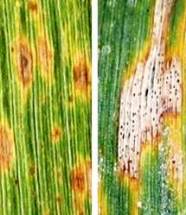Forschungs- und Innovationsprojekt
EfectaWheat – An Effector- and Genomics-Assisted Pipeline for Necrotrophic Pathogen Resistance Breeding in Wheat

Symptoms of Tan spot (left) and Septoria tritici blotch (right) on wheat leaves
Overall aim of the project is to establish a genomics- and effector-based pipeline for the genetic dissection of leaf spot group (LSG) wheat-pathogen interactions in Europe
LSG pathogens include Tan spot (TS), Septoria tritici blotch (STB), and Stagonospora nodorum blotch (SNB) caused respectively by Pyrenophora tritici-repentis, Zymoseptoria tritici, and Parastagonospora nodorum. They are considered as the most important fungal leaf spot diseases of wheat with major yield losses in Europe. The occurrence of the LSG pathogens is enhanced by nowadays common reduced tillage and mild winters. Thus, it is indispensable to control the LSG pathogens in wheat production to ensure high quality and yield. The most economical and ecologically beneficial way to reach this aim is by resistant wheat cultivars. Yet, resistance breeding is a lifelong complex task. The outcome of this project should facilitate plant breeder’s efforts towards resistance breeding, therefore.
Specific objectives
- Undertake a survey of LSG pathogens across EU partner countries to determine LSG pathogens presence and relative abundance
- Fine-scale genetic dissection of wheat LSG pathogen resistance in seedling and adult plant stage
- Establish EU-relevant LSG pathogen effector tools for effector-mediated wheat disease resistance breeding approaches
- Identify wheat effector sensitivity genetic loci
- Tagging relationships between wheat genetic loci controlling effector- and pathogen mediated host resistance
- Development of a protein and molecular toolkit for breeders including effectors and genetic markers
Methods
- Determine the exact amount of LSG pathogens on European winter wheat samples using qPCR methods
- Use of two highly recombinant eight-parent MAGIC (multiparent advanced generation intercross) winter wheat populations (LfL and NIAB) as germplasm resource for all genetic analysis
- Carrying out natural and artificial inoculated seedling tests and field trials for LSG pathogens
- Screening LfL and NIAB MAGIC populations with effectors
- Fine-scale QTL (Quantitative trait locus) mapping
- Meta-analysis of QTL mapping results
Project Information
Project leader: Dr. L. Hartl (Züchtungsforschung Weizen und Hafer/IPZ 2c), Dr. V. Mohler (Genomorientierte Züchtungsmethodik/IPZ 1d)
Project management: M. Stadlmeier (IPZ 2c)
Duration: 2016 – 2019
Funding:
Contact
Am Gereuth 8
85354 Freising
Tel.: 08161 71-3814
Fax: 08161 71-4085
E-Mail: Pflanzenbau@LfL.bayern.de



